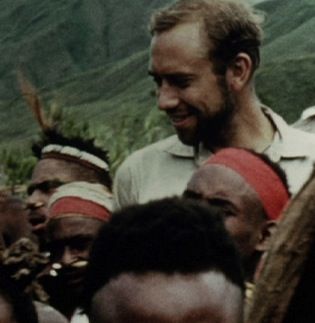
Fifty years ago, Dr. Michael Alpers went to Papua New Guinea to investigate
kuru,
a horrible sickness that killed many of the native Fore people, and no
one knew why. He ended up devoting his life to solving the mystery of
the disease. Today, the decades of research by many scientists have
added mightily to the body of biological knowledge. Kuru was not spread
by bacteria, nor by a virus, nor any distinct species, but by something
completely new to the scientific community: prions, indestructible
self-propagating proteins that change shape and attack the body. And
that was just part of the mystery. How did the Fore people become
infected, and why did some contract it while others did not? Could it
possibly be spread by the ritual of eating their loved ones who died?
“We
made a list, Carleton and I, and there were lots of changes. The
introduction of new foods, new animals, the cessation of certain
activities. But the one that was biologically the most relevant was the
mortuary practices, at least in my view.” A couple of years later, field
surveys confirmed the disease had died out in children younger than 10 —
which fitted with the kiaps effectively administering new rules of
behaviour through the district. The rules were, says Alpers, “No
fighting, build roads, no cannibalism, no child marriage, and plant
coffee. And they did it.”
When Alpers put his data together for a
presentation in Washington in 1967 “the argument for cannibalism — and I
don’t use that term anymore, but it was used then — was compelling.
Everything fitted. Why did women and children get the disease? Because
they were the ones that carried out the practice — the men didn’t. It
explained why it was dying out in young children — because the kiaps had
proscribed cannibalism. You could also conclude that the disease was
not being transmitted vertically from mother to child. No one born since
1960 was coming down with kuru. The penny dropped”.
The humbling
lesson for scientists and doctors was that while their labours might
have helped solve the puzzle, they had not halted the disease. The
honour for the life-saving intervention belonged to the officers, both
black and white, who administered the new laws of the land.
And
the research into kuru continued, because Alpers wanted to know how the
disease began, and why some who were exposed seemed to be immune. And
he's just now winding down, by getting all 2,700 of his case files in
order. The story of Dr. Alpers' battle against kuru is condensed into a
fascinating article at
The Global Mail.
 Fifty years ago, Dr. Michael Alpers went to Papua New Guinea to investigate kuru,
a horrible sickness that killed many of the native Fore people, and no
one knew why. He ended up devoting his life to solving the mystery of
the disease. Today, the decades of research by many scientists have
added mightily to the body of biological knowledge. Kuru was not spread
by bacteria, nor by a virus, nor any distinct species, but by something
completely new to the scientific community: prions, indestructible
self-propagating proteins that change shape and attack the body. And
that was just part of the mystery. How did the Fore people become
infected, and why did some contract it while others did not? Could it
possibly be spread by the ritual of eating their loved ones who died?
Fifty years ago, Dr. Michael Alpers went to Papua New Guinea to investigate kuru,
a horrible sickness that killed many of the native Fore people, and no
one knew why. He ended up devoting his life to solving the mystery of
the disease. Today, the decades of research by many scientists have
added mightily to the body of biological knowledge. Kuru was not spread
by bacteria, nor by a virus, nor any distinct species, but by something
completely new to the scientific community: prions, indestructible
self-propagating proteins that change shape and attack the body. And
that was just part of the mystery. How did the Fore people become
infected, and why did some contract it while others did not? Could it
possibly be spread by the ritual of eating their loved ones who died?
No comments:
Post a Comment